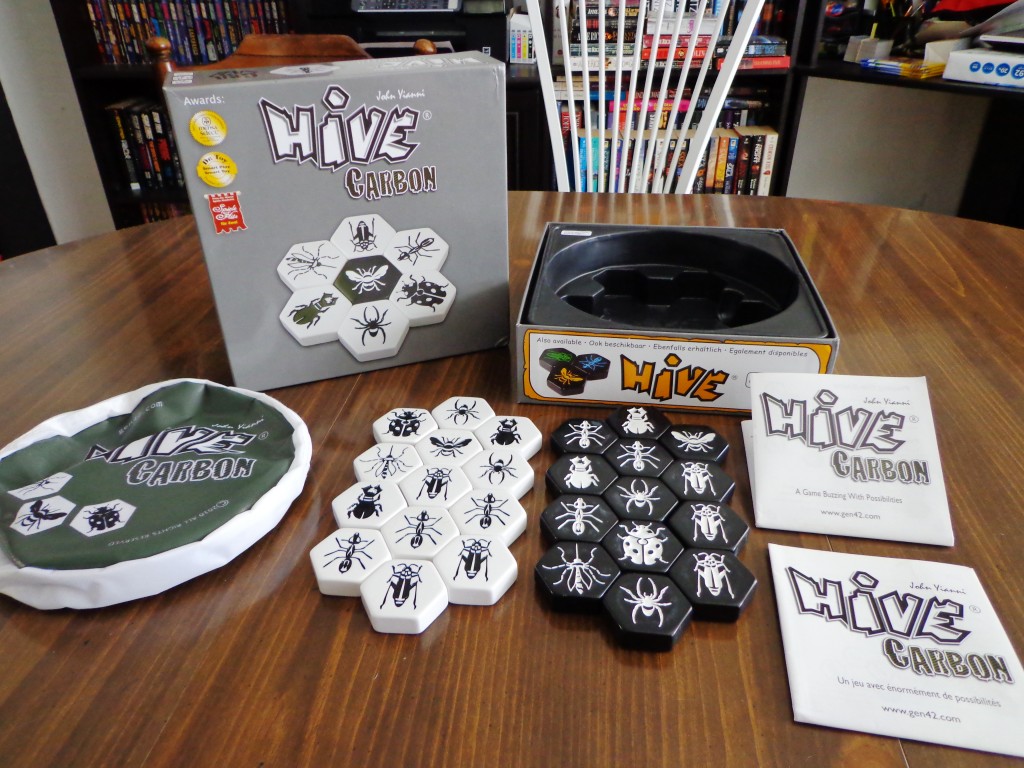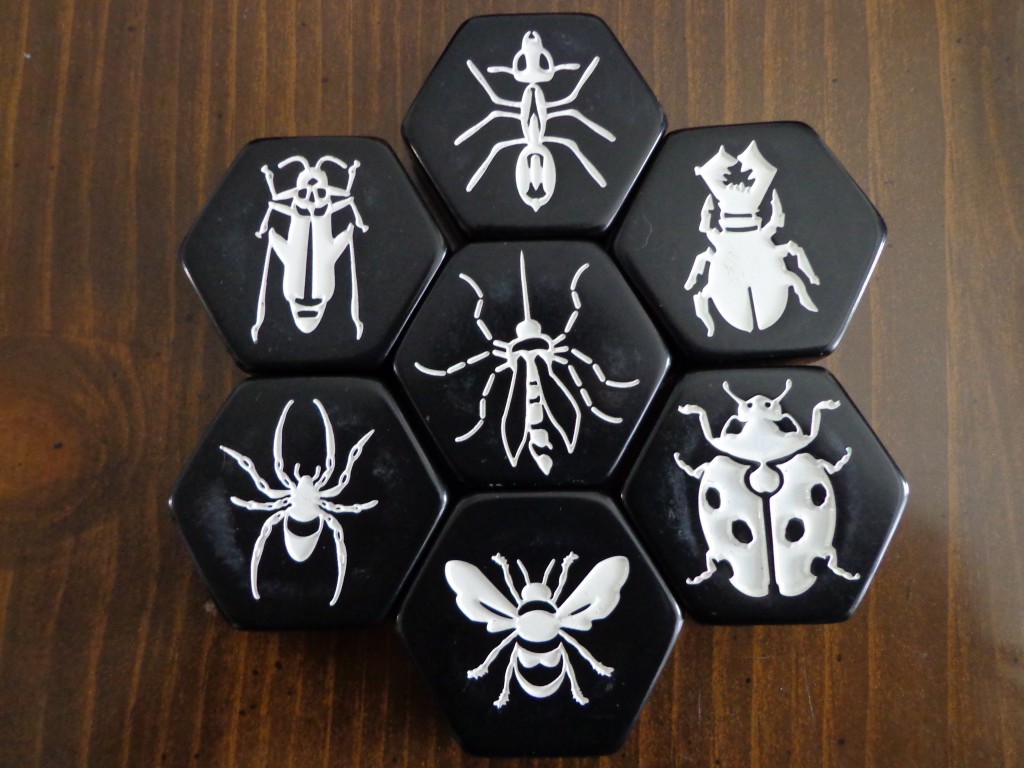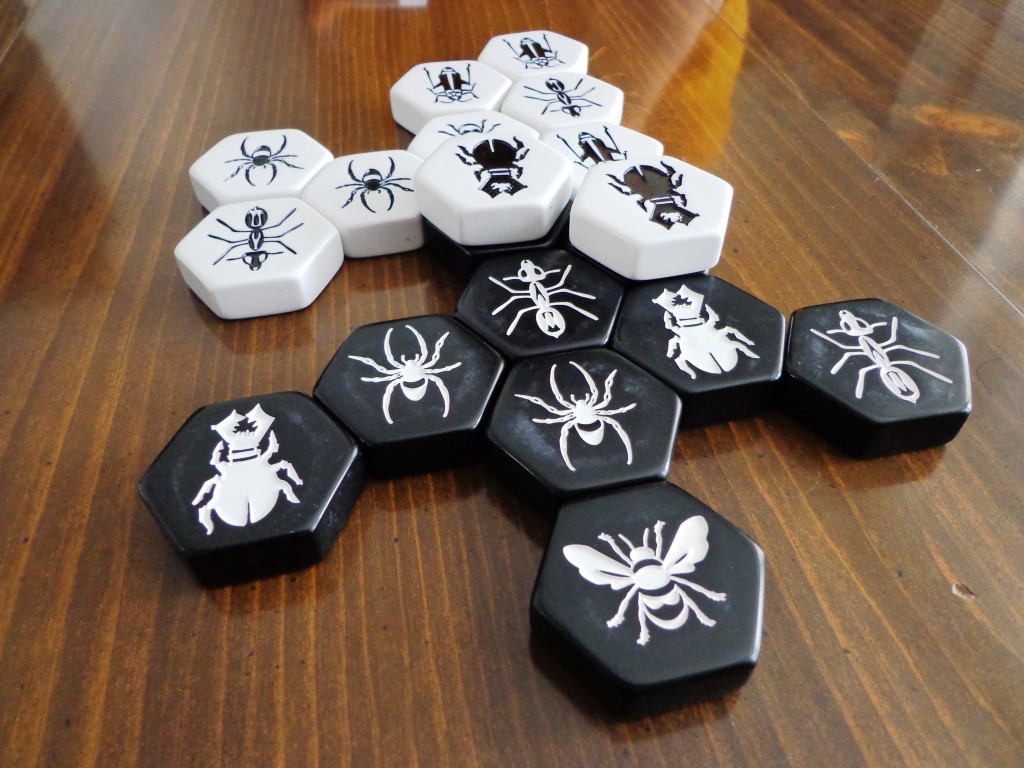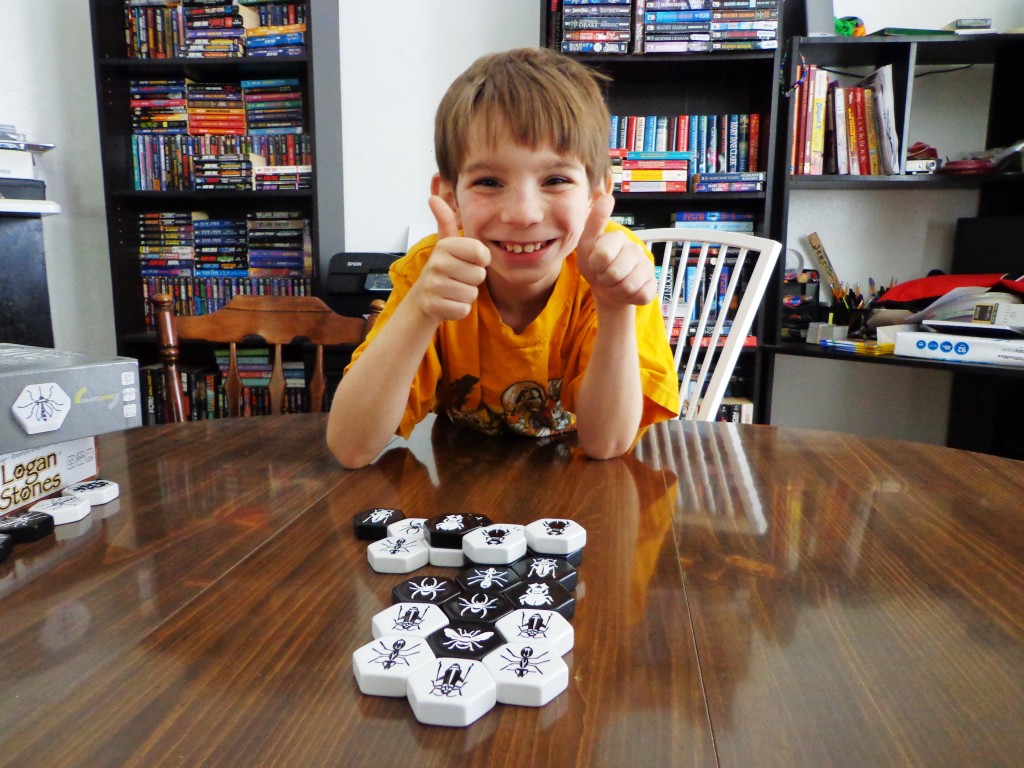My eleven year old son Vinnie was passing by my desk at home and saw “Hive Carbon”. Normally he’d pause to take a look and eventually ask me what my newest arrival was all about, but in seeing the insects on the front of the box, he expressed an interest in playing it immediately. It was a Sunday afternoon and the rain was still running rampant in our area, so why not?
Hive is a two player game in which players will be trying to move their pieces around “The Hive” to surround the enemy queen bee. Each player will have various insect pieces that move and interact with the environment differently. The original game came with queen bee, beetle, grasshopper, spider, and soldier pieces…though later on the ladybug and mosquito pieces were made available as purchasable expansions. Hive Carbon, the game I’m reviewing today, includes all of those plus has a neat portable travel bag.
Let’s take a moment to check out the components and gameplay before we head into the review.
Components
The game comes with thick, hexagonal insect pieces (black and white in color) and a round travel bag. The types of insect pieces and their individual movement rules can be summed up as follows:
Queen Bee: The queen bee moves in one space in any direction around the hive, much like a king does in Chess. If at any point this piece becomes completely surrounded by pieces of any color, the game is over.
Beetle: The beetle moves like the queen bee, except it can move on top of other pieces, preventing them from moving.
Grasshopper: The grasshopper can only jump over existing pieces and cannot move about freely.
Spider: The spider moves exactly three spaces per turn.
Soldier Ant: The soldier ant can move as many spaces as it wants.
Ladybug: The ladybug moves two spaces on top of other pieces, then goes back down to the main level on its third space.
Mosquito: The mosquito takes on the role of any piece it happens to be touching before it moves.
Gameplay
Unlike most games, there is no “board.” The game begins with players placing pieces between them while keeping the following rules in mind:
1. Players must place a new piece adjacent to one of their own and it cannot touch an enemy piece. Obviously, this rule is ignored when players are placing their very first piece.
2. All pieces must be connected to each other in some way…that is…there cannot be two separate hives. A move that would separate pieces from the hive is considered illegal.
3. The queen bee piece must be among the first four pieces that are introduced to the hive.
4. Once a piece is on the table, it cannot be removed. Pieces simply move around or on top of each other, and no “capturing” or “killing” is involved.
Players will be taking turns placing and moving pieces until one of the queen bee pieces is completely surrounded. Whoever manages to surround their opponent’s queen bee wins the game!
The above is simply an overview of the game. For detailed instructions, please check out the manual here:
The Review
It’s easy to see why this game has won so many awards, the Mensa Select award being among them. Hive is very easy to play but surprisingly has a lot of depth. It reminds me a little of Chess, except that it is more freeform. Like Chess, players are encouraged to think ahead and plan their moves.
I was a bit overwhelmed in my first game…that is…I had no idea what was considered a good move and what was considered a bad move. I found myself experimenting with the pieces, moving them around the hive, trying to see how to best use their abilities. For example, I realized that the grasshopper was an excellent way to fill a surrounded space that I needed to occupy and eventually branch out from. I also recognized the grasshopper as a deadly sniper that could jump across the hive and surround the enemy queen bee in one foul swoop. It became obvious to me however that I still have a lot of learning to do.
I particularly liked the travel case that came with the game, which allows players to pick up and go without carrying around a clunky box. The pieces themselves where solid and thick and it was fairly easy to pick out one insect from another. Kudos on the component quality.
My son and I played the game without the expansion pieces, just to get our feet wet. At first, we both had to get used to moving pieces around without causing other pieces to become separated from the hive. I was clumsily moving pieces back and forth, trying to find ways around his pieces to get to his queen bee…it was comparable to my first slow dance in grade school, minus the zits and cracking voice. The game only lasted about fifteen minutes, if that, with my son pulling ahead to victory. I was so engrossed in bringing my beetles over to his queen that I totally ignored the soldier ants that he brought around the outside, engulfing my queen bee one space at a time. All I needed was a few more moves, but he was quicker.
All in all, Hive Carbon turned out to be an excellent two player game…one that will keep me busy for a good while. I’m really looking forward to inventing (or reinventing) strategies that will improve my game. I’m sure there are player guides out there that tell players how best to use their pieces, but I look forward to unlocking those secrets myself through trial and error. If you enjoy two player games like Chess but don’t have a lot of time, then Hive Carbon will fit the bill nicely. It’s quick and easy to play, but will keep players engrossed from beginning to end.
Final Verdict: 9/10
—




